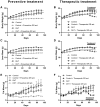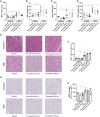Glucocorticoid Receptor Antagonism Improves Glucose Metabolism in a Mouse Model of Polycystic Ovary Syndrome
- PMID: 38169733
- PMCID: PMC10758754
- DOI: 10.1210/jendso/bvad162
Glucocorticoid Receptor Antagonism Improves Glucose Metabolism in a Mouse Model of Polycystic Ovary Syndrome
Abstract
Context: Polycystic ovary syndrome (PCOS) is a complex metabolic disorder associated with obesity, insulin resistance, and dyslipidemia. Hyperandrogenism is a major characteristic of PCOS. Increased androgen exposure is believed to deregulate metabolic processes in various tissues as part of the PCOS pathogenesis, predominantly through the androgen receptor (AR). Notably, various metabolic features in PCOS are similar to those observed after excess glucocorticoid exposure.
Objective: We hypothesized that glucocorticoid receptor (GR) signaling is involved in the metabolic symptoms of PCOS.
Methods: In a PCOS model of chronic dihydrotestosterone (DHT) exposure in female mice, we investigated whether GR signaling machinery was (de)regulated, and if treatment with a selective GR antagonist alleviated the metabolic symptoms.
Results: We observed an upregulation of GR messenger RNA expression in the liver after DHT exposure. In white adipose tissues and liver we found that DHT upregulated Hsd11b1, which encodes for the enzyme that converts inactive into active glucocorticoids. We found that preventive but not therapeutic administration of a GR antagonist alleviated DHT-induced hyperglycemia and restored glucose tolerance. We did not observe strong effects of GR antagonism in DHT-exposed mice on other features like total fat mass and lipid accumulation in various tissues.
Conclusion: We conclude that GR activation may play a role in glucose metabolism in DHT-exposed mice.
Keywords: androgen receptor; dihydrotestosterone; glucocorticoid receptor; metabolism; polycystic ovary syndrome.
© The Author(s) 2023. Published by Oxford University Press on behalf of the Endocrine Society.
Figures







Similar articles
-
Glucocorticoid signaling and lipid metabolism disturbances in the liver of rats treated with 5α-dihydrotestosterone in an animal model of polycystic ovary syndrome.Endocrine. 2021 May;72(2):562-572. doi: 10.1007/s12020-020-02600-1. Epub 2021 Jan 15. Endocrine. 2021. PMID: 33449293
-
Androgen signaling in adipose tissue, but less likely skeletal muscle, mediates development of metabolic traits in a PCOS mouse model.Am J Physiol Endocrinol Metab. 2022 Aug 1;323(2):E145-E158. doi: 10.1152/ajpendo.00418.2021. Epub 2022 Jun 6. Am J Physiol Endocrinol Metab. 2022. PMID: 35658542
-
Possible involvement of glucocorticoids in 5α-dihydrotestosterone-induced PCOS-like metabolic disturbances in the rat visceral adipose tissue.Mol Cell Endocrinol. 2015 Jan 5;399:22-31. doi: 10.1016/j.mce.2014.08.013. Epub 2014 Aug 29. Mol Cell Endocrinol. 2015. PMID: 25179821
-
Adipocyte and steroidogenic cell cross-talk in polycystic ovary syndrome.Hum Reprod Update. 2021 Jun 22;27(4):771-796. doi: 10.1093/humupd/dmab004. Hum Reprod Update. 2021. PMID: 33764457 Review.
-
Metabolic dysfunction in polycystic ovary syndrome: Pathogenic role of androgen excess and potential therapeutic strategies.Mol Metab. 2020 May;35:100937. doi: 10.1016/j.molmet.2020.01.001. Epub 2020 Feb 5. Mol Metab. 2020. PMID: 32244180 Free PMC article.
Cited by
-
A glucocorticoid spike derails muscle repair to heterotopic ossification after spinal cord injury.Cell Rep Med. 2024 Dec 17;5(12):101849. doi: 10.1016/j.xcrm.2024.101849. Epub 2024 Dec 9. Cell Rep Med. 2024. PMID: 39657663 Free PMC article.
References
-
- Meier RK. Polycystic ovary syndrome. Nurs Clin North Am. 2018;53(3):407‐420. - PubMed
-
- Azziz R, Carmina E, Dewailly D, et al. The androgen excess and PCOS society criteria for the polycystic ovary syndrome: the complete task force report. Fertil Steril. 2009;91(2):456‐488. - PubMed
-
- Goodarzi MO, Dumesic DA, Chazenbalk G, Azziz R. Polycystic ovary syndrome: etiology, pathogenesis and diagnosis. Nat Rev Endocrinol. 2011;7(4):219‐231. - PubMed
-
- Pappalardo MA, Russo GT, Pedone A, et al. Very high frequency of the polymorphism for the insulin receptor substrate 1 (IRS-1) at codon 972 (glycine972arginine) in southern Italian women with polycystic ovary syndrome. Horm Metab Res. 2010;42(08):575‐584. - PubMed
LinkOut - more resources
Full Text Sources
Research Materials
